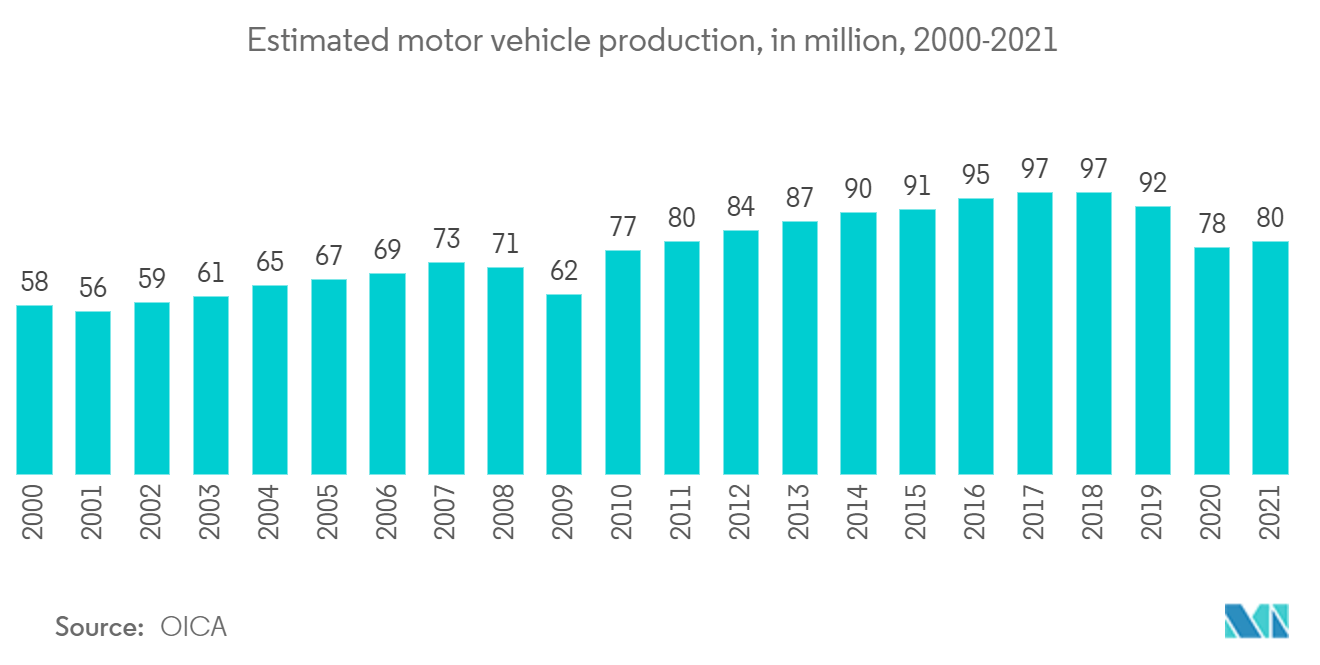Market Trends of NDT in Automotive & Transportation Industry
This section covers the major market trends shaping the NDT in Automotive & Transportation Market according to our research experts:
Eddy Current Testing Technology is Expected to Drive Growth
- Eddy current testing employs electromagnetic induction to detect and characterize surface and sub-surface flaws and defects in metallic materials. The eddy current inspection method can detect ferromagnetic and non-ferromagnetic materials. Additionally, the material is not required to have a specific electrical conductivity.
- The Eddy current detection method utilizes a device where a coil of the conductive wire is excited with an alternating electrical current. The wire coil creates an alternating magnetic field around itself. The field generated oscillates at the same frequency as the current passing through the coil. When the coil comes closer to a conductive material, currents opposed to the ones in the coil are induced in the material, known as eddy currents, according to Lenz's Law. It is mostly used in detector valves, ball pins, ring seats, and other components in automotive applications.
- The most recent generation of handheld eddy current instruments, like Zetec's MIZ-21C, have the processing power, software, and battery life to perform inspections nearly anywhere, including C-Scan functionality that offers the technician and production staff real-time visual feedback. Even when the surface is uneven or complicated geometry, eddy current coils may stay near and nominally perpendicular to the material with flexible surface probes like Zetec's Surf-X array probe.
- Some of the companies providing eddy current equipment are PCE Instruments, Trinity NDT, ETher NDE, and Bokena, among others, which provide industry-specific devices. For example, Tapered Roller Online Eddy Current Flaw Detector YZGZET-01 is used in the automotive and aerospace industries. The industry is witnessing several collaborations to leverage synergies and exploit enhanced technical capabilities, expanded manufacturing abilities, and robust investments in R&D.
- Further, eddy current inspection systems can be automated and incorporated into the production line in high-volume automotive component manufacturing scenarios. Unlike other non-destructive testing methods, in-line eddy current inspections are fast, clean, and keep the line moving. They also provide the benefit of consistency.

Asia Pacific Region is Expected to Witness Significant Growth
- At the same time of the rapid development of electronic technology and computer technology in the APAC region, NDT technology is also continuously changing in the direction of digitalization, efficiency, and more NDT technologies show the characteristics of high sensitivity, stability, and efficiency. The industry is demanding new test methods to determine the present quality of automobile parts, which is expected to influence the studied market positively. For example, in order to perform 3D SAFT (Synthetic Aperture Focusing technique) inspections, Toshiba, a Japan-based company, created the Matrixeyeultrasonic testing device, a phased array-equipped piece of equipment. The automotive sector may use Matrixeye to test welds without causing any damage, and robots can carry out the inspection automatically.
- According to the Indian Brand Equity Foundation, In FY21, India produced 22.65 million cars annually, with 13 million built between April and October 2021. Sales of electric vehicles (EVs) hit a new high of 5,592 units in the third quarter of FY22. Overall, 329,190 electric vehicles (EVs) were sold in India in 2021, representing a 168% YoY increase over the 122,607 units sold the previous year.
- Further, according to the China Association of Automobile Manufacturers(CAAM), China's production of cars (passenger cars and commercial vehicles) witnessed an increase from 25,225 thousand units in 2020 to 26,082 thousand units in 2021. Such a huge increase in automotive production, and manufacturing capacity expansions in the region, would create lucrative opportunities for the NDT market.
- Additionally, significant expenditures are being made on repairing the key infrastructure in developing nations like India, including roads, and railways, many of which are very old. The backbone of the Indian economy and infrastructural growth, the Indian Railways is one of the greatest transportation networks in the world. According to Indian railways, it has a sizable fleet of locomotives, carriages, and wagons, as well as 119,724 bridges spread across a wide network of 62,495 route miles. Hence, to carry out proper maintenance, the Indian Railway is employing non-destructive testing such as ultrasonic testing. The Indian Railway frequently conducts test runs of the diagnostic railcar with a system for continuous ultrasonic inspection made by TVEMA. Thus, maintaining infrastructure in emerging countries is likely to drive the growth of the market studied.
- Moreover, to determine the welding strength of the automotive parts and to gauge the painting thickness on the doors and body of the vehicles., several companies in the region are developing new products. For instance, in April 2021, a Japan-based company, Nikon Corporation, introduced the Lasermeister102A, a new optical processing system capable of titanium alloy additive manufacturing. A high-precision laser is used in the Lasermeister series to process metal in a variety of ways, including 3D printing, laser welding, and additive manufacturing.


